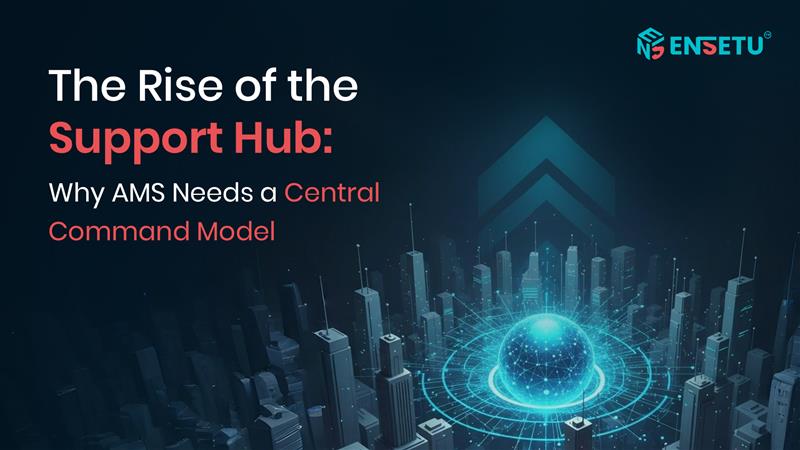
In today’s rapidly changing digital world, enterprise systems such as SAP are now at the center of an organization’s operation capabilities. They handle important workflows from finance, supply chain, and HR to customer experience. However, implementing these systems is just the first step. Ensuring the systems have a seamless operation post-go-live is just as important, and this is where Application Management Services come after implementation will be.
Although traditional AMS services focus on different teams of SAP systems and how they function for support, businesses are dynamically moving to a Support Hub model with Accountability Grants as a centralized command structure and to manage efficient and formulative support activities.
Understanding AMS and the Need for a Support Hub
Application Management Services (AMS) refer to the ongoing support, maintenance, and optimization services that the enterprise application organization will provide in their named use after deploying the application. In the SAP ecosystem, AMS ensures that business
processes continue to operate seamlessly, that systems are kept current, and that the organization can continuously leverage new system capabilities as they are introduced.
SAP support has historically consisted of several teams, such as incidents, enhancements, and systems, that would each work in a decentralized model. While this model could support smaller implementations, it could create challenges for the enterprise:
• Delays in resolving issues: When there is no centralized approach, incidents can get lost in handoffs that extend the time it takes to resolve issues.
• Quality of Service challenges: Different teams often executed different process, leading to variations in SLA compliance.
• Redundant work that resulted in inefficiencies: Overlapped responsibilities led to duplicated work and wasted time and resources.
• Limited visibility to system health and risks: Managers faced
challenges in accessing an aggregated view of system performance that would facilitate proactive management of the system.
The Support Hub model solves these problems by bringing all support functions for SAP operations into a single command and control structure. The model creates a “single source of truth” for SAP operations. This allows IT teams to be smarter, not harder, while shifting from reactive support to proactive management.
Key Components of the Support Hub Model
1. Centralized Service Desk
A centralized service desk is the first point of contact for all incidents or
requests logged from business users, or generated by automated monitoring
tools.
Advantages:
• Simplifies communication and timescales
• Accelerates routing tickets to the right subject matter expert
• Global support, 24/7 for multinational operations (SAP Help Portal)
2. Integrated Monitoring and Incident Management
Incident management integrated with real-time monitoring will proactively bring IT teams to resolve potential issues before they escalate.
Advantages:
• Quickly identify system errors before they escalate to a critical incident
• Automatically route all critical incidents to the appropriate team
• Scans past incident history to prevent similar incidents occurring in the
future
3. Unified Change and Release Management
Managing system updates and enhancements centrally ensures all changes are systematically planned, tested, and deployed.
Advantages:
• Reduces business disruptions
• Coordinates cross-functional teams for smooth implementation
• Maintains regulatory compliance and internal standards
4. Comprehensive Knowledge Base
A centralized repository for FAQs, troubleshooting guides, and standard operating procedures empowers teams and users alike.
Advantages:
• Reduces dependency on individual experts
• Empowers end-users to resolve common issues independently
• Captures lessons learned to enhance continuous improvement
Benefits of the Support Hub Model
1. Enhanced Efficiency
Centralized operations eliminate redundancies, streamline workflows, and accelerate issue resolution.
2. Improved Service Quality
Standardized processes and centralized expertise ensure consistent support outcomes, improving SLA adherence and user satisfaction.
3. Cost Savings
Optimized resource allocation, proactive maintenance, and reduced downtime lower operational costs.
4. Scalability
The centralized hub model allows organizations to scale support seamlessly as business operations grow or expand into new geographies.
5. Better Decision-Making
Centralized analytics provide insights into incident trends, system performance, and resource utilization. These insights help align IT operations with strategic business goals.
6. Proactive Risk Management
Organizations can use a combination of monitoring, incident trends, and knowledge management to prevent and mitigate risk before it reaches business-critical processes.
Implementing the Support Hub Model
A Support Hub does more than simply bring teams together. It gets people, processes, and technology aligned to enable the organization to operate information technology (IT) smoothly and stay ahead of the problem(s). A defined roadmap makes it easy to manage the transition from disparate support resources to a Support Hub structure to improve efficiency, minimize any interruptions for your end-users, and capitalize on your application management services (AMS).
1. Evaluation of Existing Processes: Assess all workflows to identify gaps leading to clear areas for centralization
2. Hub Model Design: Identify roles and responsibilities, workflows and escalation processes in the Support Hub model.
3. Tool Integration: Put in place monitoring, incident management, and knowledge management tools that allow the team to operate smoothly (see SAP Help Portal).
4. Training and Change Management: Ensure your teams are skilled to operate in a centralized environment.
5. Continuous Improvement: Regularly review performance metrics to adjust workflows, improve service level agreements (SLAs), and improve the use of resources.
Conclusion
The introduction of the Support Hub signifies a strategic shift within SAP management, moving IT from a reactive mode of support to a proactive partner creating value. By centralizing operations, organizations will benefit from improved efficiency, service
consistency, cost savings, and the ability to scale in tandem with growth.
The best part of the Support Hub is the provision of insights from data sets to enable teams to anticipate issues and address issues before they lead to downtime. In a fast-paced, digital-first environment, a Support Hub gives you the comfort of knowing your SAP systems are up to date, relevant, and continuously supporting business innovation. The Support Hub does not just
provide post-go-live support of SAP; it positions application management as a competitive advantage for organizations to stay ahead in the pursuit of operational efficiency, agility, and foresight in the future of business.